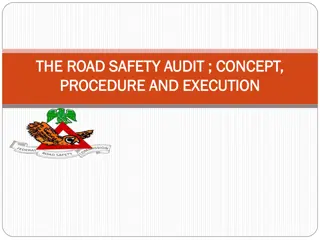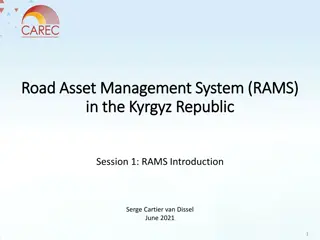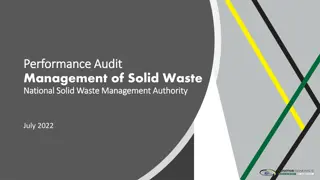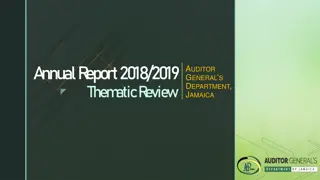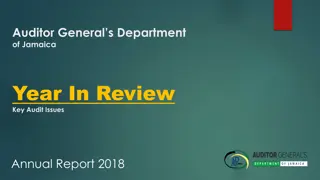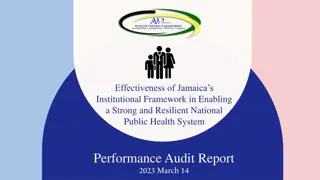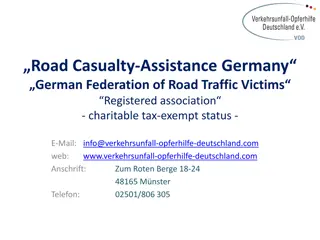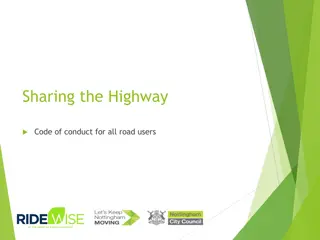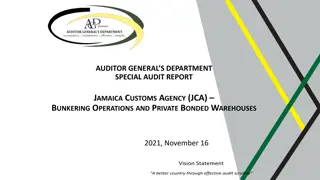Strengthening Road Management in Jamaica: Lessons Learned and Recommendations
This compendium report presents findings, lessons learned, and recommendations from performance audits conducted on road management systems in Jamaica. It focuses on key areas such as strategic management, data and information systems, procurement, and oversight. The report aims to guide the adoption of best practices to ensure value for money in road infrastructure projects for the benefit of Jamaica. Detailed analysis of combined statistics for road works over a 6-year period is provided, highlighting expenditures, sources of funds, and entities responsible. The application of Root Cause Analysis (RCA) identifies weaknesses and recommends corrective actions to improve public road infrastructure management systems.
Download Presentation

Please find below an Image/Link to download the presentation.
The content on the website is provided AS IS for your information and personal use only. It may not be sold, licensed, or shared on other websites without obtaining consent from the author.If you encounter any issues during the download, it is possible that the publisher has removed the file from their server.
You are allowed to download the files provided on this website for personal or commercial use, subject to the condition that they are used lawfully. All files are the property of their respective owners.
The content on the website is provided AS IS for your information and personal use only. It may not be sold, licensed, or shared on other websites without obtaining consent from the author.
E N D
Presentation Transcript
COMPENDIUM REPORT OF COMPENDIUM REPORT OF PERFORMANCE AUDITS PERFORMANCE AUDITS STRENGTHENING ROAD MANAGEMENT IN JAMAICA MANAGEMENT SYSTEMS FOR FARM AND PAROCHIAL ROADS December 2020
Objective Objective The Compendium provides lessons learned from the audits of road management systems at Rural Agricultural Development Authority (RADA), St. Catherine Municipal Corporation (SCMC) & Kingston & St. Andrew Municipal Corporation (KSAMC) that can guide the adoption of best practices, to enable receipt of value for money from project spending to the benefit of Jamaica.
Jamaicas Road Network Jamaica s Road Network Responsible Entities Responsible Entities
Application of Root Cause Analysis (RCA) Application of Root Cause Analysis (RCA) Aim of the RCA Identified RCAs Expected Outcomes Lessons learned will assist Parliament, Government and stakeholders to better understand the factors affecting public road infrastructure management systems The root causes of identified weaknesses mainly fell into four key areas across each entity To assist in identifying whether weaknesses at RADA, SCMC and KSAMC were systemic or unique 1. Strategic Management 2. Data & Information Management Systems; 3. Procurement & Contract Management 4. Monitoring & Oversight Whether a broad-based Government response or targeted corrective action for the specific entity was required To better identify the associated risks to the achievement of related economic goals
Combined Statistics for Road Works Combined Statistics for Road Works over a 6 over a 6- -Yr period: Yr period: RADA, SCMC and KSAMC Public Body Audited Period Source of Funds Expenditure 2015-16 to 2018- 19 $1.74bn Ministry of Agriculture RADA RADA, 22% 2014-15 to 2018- 19 $2.2bn Parochial Revenue Fund, Equalization Fund SCMC RADA SCMC KSAMC, 51% KSAMC 2014-15 to 2019- 20 $4.1bn Parochial Revenue Fund, Constituency Development Fund, Equalization Fund & Tourism Enhancement Fund KSAMC SCMC, 27% TOTAL $8.04bn
Analysis of combined statistics for road works Analysis of combined statistics for road works over a 6-Yr period: RADA, SCMC and KSAMC No. of Road Contracts presented 769 KSAMC accounted for 82% of contracts presented Value of Road works $8.04bn
Identified Good Practices Identified Good Practices Procurement & Contracts Management Strategic Management Practices Data & Information Management Systems Monitoring & Oversight RADA had inspection Checklists to verify that road works meets the required standards; qualified staff to monitor road works RADA had functioning Board of Directors and sub- committees; key quality requirements for general road work activities RADA maintained comprehensive contract files supporting the award of contracts RADA developed priority listings of farm roads to be rehabilitated SCMC had Functioning Council and sub- committees; Local Sustainable Development Plan for the parish; qualified and trained staff SCMC monthly reports prepared by the Road and Works Department provided detailed overview of road work activities SCMC had Local Public Accounts Committee to monitor the Municipal Council and recommend any corrective actions SCMC engaged a procurement officer and established a procurement committee KSAMC implemented in March 2020, a Collector Road Inspection Schedule for some roads, detailing their status and recommendations KSAMC is implementing actions to improve the technical support of the procurement unit KSAMC maintained log of citizens complaints KSAMC had functioning Council and sub- committees; Qualified and trained engineering staff
Identified Deficiencies Identified Deficiencies Local Competitive Bidding (LCB) 9%Unknown, 11240000 Direct Contract (DC) - 37% Limited Tender (LT) - 50% DCE, 93983555 DC DCE LT LCB Unknown Although the competitive tender provides the best opportunity for receipt of value for money, only 9 per cent of contract awards were made using this methodology.
Identified Deficiencies Identified Deficiencies Strategic Management Practices Data & Information Management Systems Procurement & Contracts Management Monitoring & Oversight RADA had no medium-long term strategic approach, management of farm roads limited to selected annual rehabilitation projects. RADA could not justify basis for direct and emergency contracts; No basis for pre-selection of contractors for limited tender awards. RADA: Inconsistent application of quality standards; no notations on inspection checklists such as frequency of testing, road conditions or nature of works. RADA did not have a comprehensive database of roads; farm road records undated. SCMC failed to develop strategic plans in compliance with the Local Government Act 2016; hence the absence of agreed targets and KPIs SCMC did not have a comprehensive database of parochial roads under its purview; its records of roads dated 1975 SCMC could not justify emergency classification for 23 contracts ($22mn); 11 instances ($15.4mn) found where work commenced before agreements signed. SCMC: Inconsistent application of guidelines and standards for drainage, earth and pavement works; For Lengthman works, no logs or inspection reports KSAMC did not have a comprehensive database of roads under its purview; its record of roads dated 1992 KSAMC did not consistently prepare strategic plans and where existed, were in draft and not approved; hence no agreed targets or KPIs. KSAMC records showed direct and emergency contracting accounted for almost 90% of 630 contracts; no records to support basis for pre-selection of contractors. KSAMC: Inconsistent application of quality standards and guidelines for road maintenance works; no evidence of inspection checklists and logs.
Common Issues in Contract Management Common Issues in Contract Management RADA SCMC KSAMC Frequent use of emergency contracting methodology but could not demonstrate that allowable circumstances were met. Frequent use of emergency contracting methodology, but could not demonstrate that allowable circumstances were met. Frequent use of emergency contracting methodology, but could not demonstrate that allowable circumstances were met. No documentation to show that contractors were assessed for minimum qualifying criteria such as experience, management and technical expertise. No documentation for selection and award of contractors for 55 road work projects ($121 mn), and 6 contracts ($38.8 mn); and instances of work starting before agreements signed. No documentation to support pre-selection and award of contracts based on limited tender methodology for 64 contracts ($253 mn).
Lessons Learned Lessons Learned A multi-agency wholistic approach is required for the development of strategic plans. To enable the efficient allocation of resources, a medium to long term approach is to be taken. The appropriate KPI and targets must be clearly established and aligned and aligned with annual budgets to ensure the delivery of the entities' mandates. Portfolio Minister is to ensure that strategic plans are prepared and approved and require adherence to the Local Government Act in respect of community input. t To achieve full value for money, entities should adhere to the Government's procurement guidelines and seek to implement the proper due diligence prior to the award of contract to ensure contractors meet the minimum qualifying criteria. Proper planning will facilitate opportunities for competitive bidding to achieve best price. Data & Information Management Procurement & Contract Management A robust electronic road inventory platform that provides information on all roads by types, condition, location and responsible entities. This would facilitate efficient strategic planning and alignment of operational plans with annual budgets based on priority needs. The system would also enable cross-entity planning, facilitate economies of scale and coordinated funding strategies, given the scarce fiscal resources. To provide verifiable assurance that road works are done to standard and that contractors can be held to account, quality guidelines are necessary to ensure roads are maintained in accordance with their useful life. The use of logs and checklists are important tools which facilitate monitoring contractors in terms of actual works done, against targets in order to hold them to account. Strategic Management Monitoring & Oversight
Lessons Learned Lessons Learned Absence of public input Non- Affects public satisfaction compliance with Local Govt Act Limits Alignment of budgets with identified projects No Medium to Long term Planning Strategic Approach & Limits




